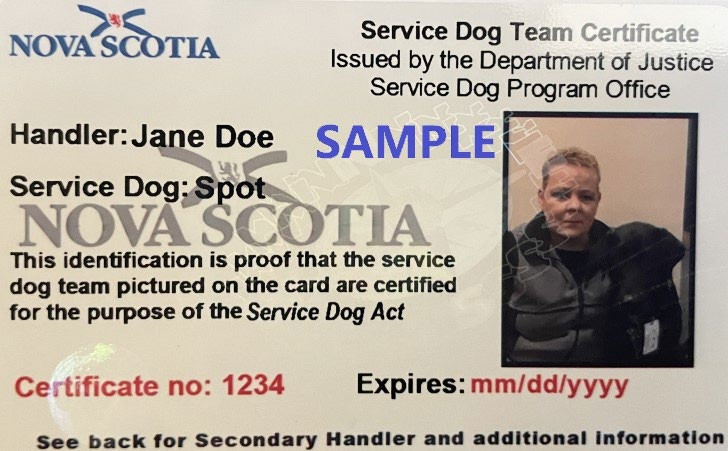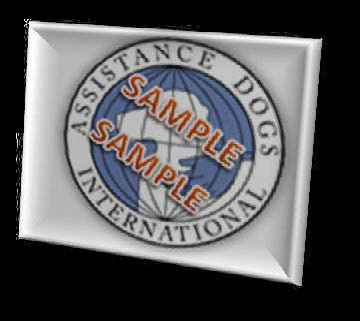Service Dog Information for Restaurants
Service Dog Frequently Asked Questions
Guide Dogs and Service Dogs in Nova Scotia
What are guide dogs and service dogs?
Guide and Service Dogs are NOT PETS. They are medical aids to assist persons with disabilities with their daily lives. Equal to all members of the public, people with a disability, who use a guide or service dog, have rights to equal access and use of public places and services, and are protected under the NS Human Rights Act.
A guide dog is a dog that has been trained to assist individuals who are blind or visually impaired. A guide dog team (the guide dog and the blind or visually impaired person they are assisting) has protections under the Blind Persons’ Rights Act (BPRA) and they are protected against any discrimination under the Human Rights Act.
Important: Guide Dog Teams are not issued a Nova Scotia provincial identification card under the BPRA as they have consistent visual identification practices recognized by the public.
A service dog is a dog that has been trained to assist an individual with specific tasks pertaining to a visible or non-visible disability. There are many types of service dogs, including hearing dogs, assistance dogs for people with mobility impairments, special skills dogs that detect oncoming seizures and dogs trained to support persons living with post-traumatic stress disorder (PTSD).
A service dog team (the service dog and the disabled person they are assisting) that wish to have protections under the SDA may apply for provincial identification. Certification under the SDA is voluntary.
Business and Service Providers - Responsibilities:
What must I do when an individual with a guide or service dog comes into my business?
Individuals with qualified guide and service dogs are allowed entry into all places where the public is allowed. Businesses should keep the following information in mind:
• A person with a disability who uses a guide dog or service dog should not be stopped or questioned unless there is a concern. The best way to recognize a guide or service dog is by observing the behaviour of the dog and handler.
• Guide or service dog handlers must be treated with dignity and respect. Do not ask personal questions about the handler’s disability and do not ask for the dog to demonstrate its task.
• An individual with a guide or service dog must not be segregated from other customers (do not limit access or assign a person with a disability who is using a guide or service dog to pet friendly areas).
Do not interact with a guide or service dog. They are working dogs so do not distract the dog or interfere with their job. Do not pet or touch the dog and never offer food to a service dog.
It is an offence to deny public access to people with qualified service dogs under the Service Dog Act or guide dogs under the Blind Persons’ Rights Act can be fined.
If the guide or service dog is misbehaving after I have talked with the handler, can I ask the dog team to leave?
Owners of guide or service dogs are responsible for the behaviour and are required to have their dogs under control. This means their dogs should not growl, bark aggressively, snap, bite, lunge at anyone, seek food or occupy a seat.
If you have made attempts to handle the situation and the dog is still exhibiting disruptive behaviours, like anyone acting inappropriately, a person may be refused access or asked to leave if they or their guide or service dog is disruptive. Staff would follow business guidelines for recording incidents within their establishment.
If someone is allergic or has a fear of dogs, what should I do?
If your customers or employees have allergies or a fear of dogs, they may make their concerns known to you and ask that you make alternate arrangements for them.
How to identify a guide or service dog?
Guide dogs have well established standards and consistent visual identification practices (special harness with a long U-shaped handle that the blind partner holds onto).
Service dogs should be clearly identified as a service dog by wearing a vest or a collar that states “service dog”, however, not all are, and additional inquiry may be required.
The most basic way to identify a legitimate service dog is by the behaviours they exhibit. It is reasonable to expect the guide or service dog to be well behaved, calm and focused on the handler and their job. In other words, it must NOT:
• Be aggressive or put others at risk
• Growl, bark aggressively, snap, bite or lunge at anyone (note: a service dog may alert bark if that is required (i.e., if a person’s blood sugar drops)
• Seek attention or food or occupy a seat
• Run freely, urinate or defecate in inappropriate areas
• Damage property
• Look nervous or anxious
• Drag or pull their handler (pulling on leash)
Is there a specific kind of dog breed to help me identify a guide or service dog?
Various dog breeds are engaged as guide dogs and service dogs. There is no legislation that determines what breed a guide dog or service dog must be.
Identification Cards for Service Dog Teams
Service dog owners may be asked to show identification to verify they are qualified. If a person cannot produce identification or show proof their service dog is qualified, their rights to public access are not guaranteed.
The following questions may be asked to help verify a dog is a qualified service dog:
Q. Is the dog certified with the Province of Nova Scotia under the Service Dog Act?
A. If yes, a provincial service dog team ID card would be presented. The card contains the Nova Scotia logo and a clear picture of both the service dog and handler.
Government of Nova Scotia ID card:

Q. Is the dog certified from a training school accredited by Assistance Dog International (ADI) or International Guide Dog Federation (IGDF)?
A. If yes, a training school accredited by (ADI) or (IGDF) would usually contain the following logo:
ADI school logo

IGDF logo

Assistance Dogs International (ADI) – Link to Map of Accredited Members
International Guide Dog Federation (IGDF) – List of Guide Dog Providers in North America
If a person is not able to provide identification, you may ask for information to confirm the dog is required as a service dog and the dog has received formal training and is safe for public access. (These are general guidelines only; organization must determine best practices for obligation to accommodate).
• This may be supported by a medical note confirming the requirement for the assistance of a service dog and information related to the service dog’s training. You are not allowed to ask about a person’s disability. (The dog should be in control, quiet, beside the handler)
Here is the link for more information regarding the service dog assessment and the 40 exercises that assess if a dog is calm, stable and reliable in situations that dog and hander teams commonly encounter.
Dogs-in-Training to become a Guide Dog or Service Dog
Are guide or service dogs-in-training allowed access to public places?
Dogs being trained for purposes of becoming a guide dog or a service dog may be allowed access to public places for training purposes when the dog is accompanied by a dog trainer. A person training a dog may have to provide evidence to demonstrate that the dog-in-training is necessary, and that the person is qualified to train the dog.
General Questions
What do I do if a pet dog is reacting to a service dog on a dog-friendly patio?
Pet dogs should not be inhibiting other patrons, including those with accessibility issues.
Restaurants will have the right to ask owners to remove their dogs if they aren’t behaving.
I have a “no pets” policy at my business. Do I still have to allow a guide or service dog in?
A guide or service dog is not a pet. You will need to modify your pet policy to allow the use of a guide or service dog by a person with a disability. A clear policy permitting guide or service dogs can help ensure that staff are aware of their obligation to allow access to customers using a guide or service dog.
Here is the link for more information regarding the service dog assessment and the 40 exercises that assess if a dog is calm, stable and reliable in situations that dog and hander teams commonly encounter.
Contact:
For more information, visit our website: https://novascotia.ca/servicedogs/ or to request a Guide and Service Dog Welcome decal to place on your door or window, or a Guide Dog/Service Dog poster, contact the Department of Justice, Service Dog Program Office:
Toll free: 1-888-760-5577 (press 6) Halifax Area: (902)424-8805
Email: servicedogs@novascotia.ca


